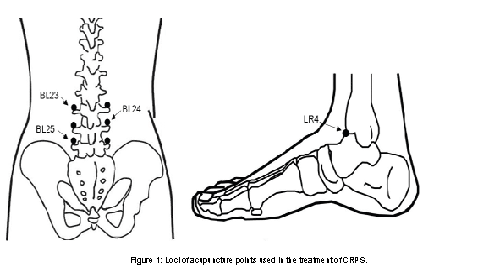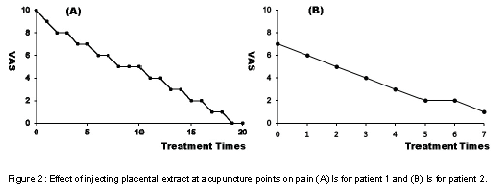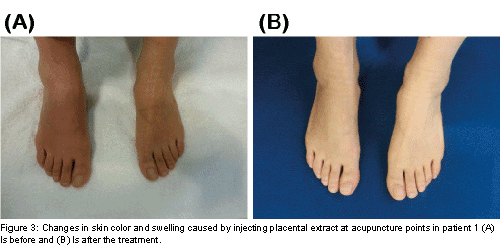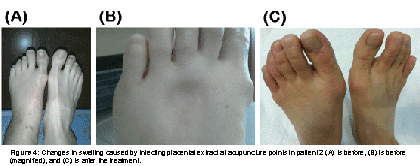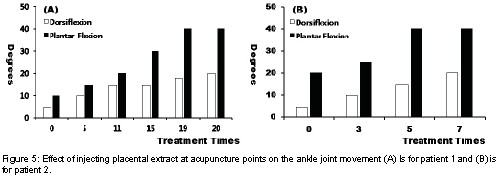Case Report Open Access
Use of Acupuncture Point Injection with Placental Extract for Treatment of Complex Regional Pain Syndrome
Tae Hwan Cho1 and Kyeong Mee Park2*
1Cho Orthopdaedic Clinic, South Korea
2Inno Oriental Clinic, South Korea
- *Corresponding Author:
- Kyeong Mee Park
Inno Oriental Clinic, Yusung-Gu
Daejon, 34014 South Korea
Tel: 82-42-671-9933
Fax: 82-42-671-9969
E-mail: kmpark02@empas.com
Received March 04, 2016; Accepted May 05, 2016; Published May 09, 2016
Citation: Cho TH, Park KM (2016) Use of Acupuncture Point Injection with Placental Extract for Treatment of Complex Regional Pain Syndrome. J Pain Relief 5:246. doi:10.4172/2167-0846.1000246
Copyright: © 2016 Cho TH, et al. This is an open-access article distributed under the terms of the Creative Commons Attribution License, which permits unrestricted use, distribution, and reproduction in any medium, provided the original author and source are credited.
Visit for more related articles at Journal of Pain & Relief
Abstract
Complex regional pain syndrome (CRPS) is an inflammation-associated disorder which develops as a consequence of limb-confined trauma. The disease is characterized by spontaneous pain, swelling, skin color change, and movement disorder. Here, we report two cases studies on the remarkable amelioration of CRPS by the injections of placental extract into acupuncture points. A 59-year-old female patient with CRPS after 6 week-casting due to a fracture on the right metatarsal bone showed symptoms of severe pain, reddish skin color change, swelling, and restricted articular movement. Another 49-year-old female patient with CRPS after an arthroscopic surgery on the left ankle joint suffered from pricking pain, swelling, and movement restriction in the foot. Acupuncture points BL23, BL24, BL25, and LR4 localized on low back and ankle joint of both patients, were selected for application of placental extract. Both parents showed complete pain relief, swelling remission, redness disappearance, and articular movement restoration.
Keywords
Complex regional pain syndrome (CRPS); Acupuncture point injection; Placental extract; Anti-inflammatory
Introduction
Complex regional pain syndrome (CRPS) is a painful condition developed after a traumatic injury of extremities. While the pathophysiology of CRPS has not clarified yet, the roles of excessive regional inflammation, peripheral sensitization of primary somatosensory afferents, and central sensitization of spinal neurons associated with the symptoms of this disorder have been intensively investigated [1,2]. The major focus in treatment of CRPS is to alleviate pain and maintain maximum function. A number of drug or interventional treatments that may provide pain relief have been described: spinal cord stimulation, paravertebral sympathetic ganglion nerve blockade, corticosteroid, ketamine, and acupuncture [3-7]. However, confirmatory trials are still required before recommendations can be given. Two case reports and two randomized trials have reported that long-term acupuncture treatment reduced pains in CRPS patients [7-10]. However, no significant improvement of other inflammatory parameters of CRPS, including swelling, mobility, temperature, and redness, could be proven in comparison with sham-treated patients [7-10].
In order to maximize the therapeutic effect of acupuncture, potential use of acupuncture point injection (API) with pharmacological medication or purified herbal medicine has been recently attempted [11-13]. There is a report that API with bee venom significantly abated pains as compared with manual acupuncture alone in patients with herniated intervertebral disc [14]. Moreover, API with placental extract was known to result in a significant improvement in various inflammatory symptoms of a CRPS patient [15].
In the present study, we report two cases studies showing the amelioration by the API with placental extract in the patients suffering from pain, swelling, and immobilization after traumatic injuries on the lower extremity.
Materials and Methods
Patient 1
A 59-year-old woman suffered from trauma to the dorsum of the right foot complained of immediate pain in the traumatized area. A radiological examination revealed a sharp fracture on the metatarsal bone of her right foot. Because the patients were unable to bear weight on her lower extremity and felt a severe pain during movement, she wore a cast for 6 weeks by the prescription of a doctor in the nearby clinic. After removal of a plaster cast, she felt severe pain in her right foot which was swollen, immobilized, and reddish. Over the next 4 weeks, she got physical therapies including massage and transcutaneous electrical nerve stimulation on the affected foot every two days. However, her symptoms were not improved after the extensive therapies. When she presented in our clinic 10 weeks after the traumatic injury, the patient’s right foot and ankle were immobilized. Examination of sensory sensation revealed that her right lower extremity demonstrated exaggerated response for pain, touch, temperature, and proprioception. Moreover, a burning, sharp pain was produced by placing a hot pack on the dorsum of the foot and lateral aspect of the leg. The right foot showed a reddish appearance with non-pitting edema. According to the criteria for CRPS of Iinternational Association for the Study of Pain, her case was diagnosed as CRPS.
Patient 2
Another subject chosen for this study was a 49-year-old woman suffered from the continuous pain on the left ankle joint due to the osteosynovitis for one year. In order to relieve pain, an arthroscopic surgery was performed on her left ankle joint. However, the pain and swelling were not improved after the operation. The patient kept complaining of the spontaneous pain as well as the induced pain of the left foot. The patient received transcutaneous electrical nerve stimulation therapy to the affected foot twice a week for three months in the nearby clinic. Analgesic, dexibuprofen, was also orally administered to the patient over three months. When she first visited our clinic, the pain of the patient was no longer continuous but hardly tolerable. Ankle movement of her left foot was restricted due to the pain. The left foot of the patient was swollen as compared with the right foot. The maximum circumferential measurement of her feet were 25.5 cm on the left whereas 24 cm on the right. The patient felt cold sensation on the left foot even under room temperature conditions. The test results were diagnosed as CRPS according to the criteria for CRPS of Iinternational Association for the Study of Pain.
Preparation of placental extract
Human placental extract obtained under the regulations of the Korean Food and Drug Administration, Laennec, was purchased from Green Cross Ltd. (Yongin, Korea). Human placentas, collected upon full-term delivery, were tested for human immunodeficiency virus and hepatitis B and C viruses. They were cut into pieces, defatted with acetone, and extracted with water through pepsin and hydrochloric acid-catalyzed hydrolysis. Resulting placental extract was tested for germ-free, anti-histamine, and endotoxin-free under the regulation of Korean Food and Drug Administration. The final placental extract product was sterilized, packaged at 2 ml/ampule, and approved for injection for human by subcutaneous and intramuscular. Insoluble macromolecules, such as polysaccharide, polynucleotide, etc. were excluded during the manufacturing processes.
Injection of placental extract into acupuncture points
The patients gave their informed written consent for this study. The placental extract was weekly injected into acupuncture points BL23, BL24, BL25 (for both sides), and LR4 (for the affected side) (Figure 1). Every two milliliters of placental extract was injected into acupuncture points BL23, BL24, BL25, and LR4 by using a plunger with a 26-gauge needle. The pain score was recorded by using the visual analogue scale (VAS) on which a score of zero means no pain and a score of 10 means the worst pain possible. Each patient was asked to indicate her feeling of pain by drawing a vertical line on a 10 cm VAS before and every week after placental extract injection.
Results
Recently, API has been emerged as a potential therapy for various diseases [11-15]. It is a new acupuncture therapy that combines acupuncture and medication, and hence accomplishes more effective therapeutic outcomes than acupuncture alone [16]. Present study deals with injecting placental extract into acupuncture points in the CRPS patients traumatized with the lower extremity.
Acupuncture points BL23, BL24, and BL25 were taken for both sides whereas acupuncture point LR4 was taken for the affected side (Figure 1). The initial VAS scores were 10 for patient 1 and 7 for patient 2. As for patient 1, after the 8th treatment of placental extract, the VAS score decreased to 5 (Figure 2); in addition, slight diminutions of numbness, hot sensation, and swelling of the right foot were noted. By the 15th treatment, the VAS score fell to 2, and both reddish skin color and swelling of the right foot completely disappeared (Figure 2). Finally, the VAS was o after the 19th treatment (Figure 3). As for patient 2, after the 5th treatment of placental extract, the VAS score decreased to 2 (Figure 3); in addition, swelling as well as cold sensation of the left foot was dramatically removed (Figure 4). After the 7th treatment, the VAS score fell to 1 (Figure 2).
Before the injection of placental extract into the acupuncture points, the movement of the right ankle joint was highly restricted, angles of 5 degrees for dorsiflexion and 10 degrees for plantar flexion for patient 1 (Figure 5). However, the range of motion of the right ankle joint gradually increased as placental extract was consecutively injected into the acupuncture points; being 15 degrees for dorsiflexion and 20 degrees for plantar flexion after the 11th treatment, and finally 20 degrees for dorsiflexion and 40 degrees for plantar flexion after the 20th treatment (Figure 5). As for patient 2, the movement of the left ankle joint was 5 degrees for dorsiflexion and 20 degrees for plantar flexion before the treatment (Figure 5). However, the consecutive injection of placental extract into the acupuncture points improved ranges of the movement of the left ankle joint; being 15 degrees for dorsiflexion and 40 degrees for plantar flexion after the 5th treatment and finally 20 degrees for dorsiflexion and 40 degrees for plantar flexion after the 7th treatment (Figure 5).
Discussion
An outcome of API depends on the loci of acupuncture points and the nature of medication. In equal to our previous study, placental extract was chosen for its anti-inflammatory nature [15]. Since the patients in the present study suffered from pain and immobilization of the lower extremity, we chose the acupuncture points localized on the facet joints of lumbar vertebrae as well as the acupuncture point localized on the ankle joint. According to recent reports, there are much compelling evidence between lumbar spinal disease and lower extremity arthrosis [17,18]. Using 710 randomly selected cadaveric specimens, a significant association was found between lumbar disc degeneration and tibiotalar joint arthritis [18]. A cross sectional study comparing normal subjects and patients with lumbar disc herniation with sciatica revealed that ankle plantar flexion torque was significantly lower in the lumbar disc herniation group than the control group [19]. Moreover, in a preliminary study with collegiate football players, low back dysfunction and suboptimal endurance of the core musculature appear to be important injury risk factors for strains and sprains of foot [20]. Therefore, it seems that the choice of acupuncture points BL23, BL24, and BL25, which are located on the facet joints of the 2nd, 3rd, and 4th lumbar vertebra respectively, is suitable for the treatment of the CRPS patients affected with the ankle joint. At the same time, API to acupuncture point LR4 on the affected ankle joint is pertinent to relieve pain and recover mobility because joint dysfunction can cause muscle hyperalgesia [21].
In respect to needling method of acupuncture, there are two methods; one is superficial needling to a depth of 2 mm and the other is deep needling to a depth of 20 mm or more. Because the blockade of nervous afferent fibers from the skin did not eliminate the acupuncture analgesia whereas the anesthetic blockade in deep tissue did eliminate acupuncture analgesia [22], the deep needling gained popularity for relieving muscle-derived pain more effectively than the superficial one [23]. Besides, the facet capsules and adjacent tissue are rich in nociceptive receptors, which causes pain when the capsules are irritated by mechanical stimulation or inflammation [24,25]. Hence, the deep API into acupuncture points BL23, BL24, and BL25 may produce greater activation of sensitized polymodal-type receptors, resulting in stronger effects in pain relief. In addition, injection into acupuncture points BL23, BL24, and BL25 might relieve the fatigue of the lumbar extensor muscles stabilizing the ankle proprioceptive acuity.
According to Chen et al., injections of bee venom, normal saline, and vitamins B1 and B12 into acupuncture point ST36 activated neuronal signaling compared to a dry needling as a control [26]. They suggested that both the spatial configuration changes and liquid substrate stimulate the acupuncture point and activate neuronal signal transmission system [26]. Therefore, the distension achieved by intraarticular injection of placental extract into acupuncture points LR4 seems to facilitate the movement at the site of disable joints. The distension could also serve a local volume reservoir from which the supposed anti-inflammatory compound in the placental extract is subsequently absorbed.
Conclusions
We conclude that a long-term injection of placental extract into acupuncture points BL23, BL24, BL25, and LR4 relived pain, eliminated swelling, and recovered mobility in the affected lower limb in CRPS patients. These results imply that the medicinal effects of placental extract and acupuncture synergistically act to improve CRPS symptoms.
References
- Huygen FJ, de Bruijn AG, Klein J, Zijlstra FJ (2001) Neuroimmune alterations in the complex regional pain syndrome. Eur J Pharmacol 429: 101-113.
- Huygen FJ, De Bruijn AG, De Bruin MT, Groeneweg JG, Klein J, et al. (2002) Evidence for local inflammation in complex regional pain syndrome type 1. Mediators Inflamm 11: 47-51.
- Geurts JW, Smits H, Kemler MA, Brunner F, Kessels AG, et al. (2013) Spinal cord stimulation for complex regional pain syndrome type I: a prospective cohort study with long-term follow-up. Neuromodulation 16: 523-529.
- Rocha Rde O, Teixeira MJ, Yeng LT, Cantara MG, Faria VG, et al. (2014) Thoracic sympathetic block for the treatment of complex regional pain syndrome type I: a double-blind randomized controlled study. Pain 155: 2274-2281.
- Atalay NS, Ercidogan O, Akkaya N, Sahin F (2014) Prednisolone in complex regional pain syndrome. Pain Physician 17: 179-185.
- Azari P, Lindsay DR, Briones D, Clarke C, Buchheit T, et al. (2012) Efficacy and safety of ketamine in patients with complex regional pain syndrome: a systematic review. CNS Drugs 26: 215-228.
- Hill SD, Lin MS, Chandler PJ Jr (1991) Reflex sympathetic dystrophy and electroacupuncture. Tex Med 87: 76-81.
- Korpan MI, Dezu Y, Schneider B, Leitha T, Fialka-Moser V (1999) Acupuncture in the treatment of posttraumatic pain syndrome. ActaOrthopBelg 65: 197-201.
- Leo KC (1983) Use of electrical stimulation at acupuncture points for the treatment of reflex sympathetic dystrophy in a child. PhysTher 63: 957-959.
- Chan CS, Chow SP (1981) Electroacupuncture in the treatment of post-traumatic sympathetic dystrophy (Sudeck's atrophy). Br J Anaesth 53: 899-902.
- Strudwick MW, Hinks RC, Choy STB (2007) Point injection as an alternative acupuncture technique--an exploratory study of responses in healthy subjects. Acupunct Med 25: 166-174.
- Cheon S, Zhang X, Lee IS, Cho SH, Chae Y, et al. (2014) Pharmacopuncture for cancer care: a systematic review. Evid Based Complement Alternat Med 2014: 804746.
- Song H, Choi J, Kang J, Lee H (2009) The effect of the acupuncture therapy in combination with soyeompharmacopuncture therapy on the improvement of the symptoms of the patients with herniated intervertebral disk of L-spine in his initial stage of hospitalization. Journal of Korean Pharmacopuncture Institute 12: 111-118.
- Yu S, Lee J, Kwon K, Lee H (2006) Comparative Study of Acupuncture, Bee Venom Acupuncture, and Bee Venom Pharmacopuncture on the Treatment of Herniation of Nucleus Pulpous. The Journal of Korean Acupuncture &Moxibustion Society 23: 39-54.
- Cho TH, Park KM (2014) Complex regional pain syndrome type 1 relieved by acupuncture point injections with placental extract. J Acupunct Meridian Stud 7: 155-158.
- Kwon YB, Lee JD, Lee HJ, Han HJ, Mar WC, et al. (2001) Bee venom injection into an acupuncture point reduces arthritis associated edema and nociceptive responses. Pain 90: 271-280.
- Pline KM, Madigan ML, Nussbaum MA, Grange RW (2005) Lumbar extensor fatigue and circumferential ankle pressure impair ankle joint motion sense. NeurosciLett 390: 9-14.
- Boiwka AV, Bajwa NS, Toy JO, Eubanks J, Ahn NU (2015) Lumbar degenerative disc disease and tibiotalar joint arthritis: a 710-specimen postmortem study. Am J Orthop (Belle Mead NJ) 44: E100-105.
- Chen LC, Kuo CW, Hsu HH, Chang ST, Ni SM, et al. (2010) Concurrent measurement of isokinetic muscle strength of the trunk, knees, and ankles in patients with lumbar disc herniation with sciatica. Spine (Phila Pa 1976) 35:E1612-E1618.
- Wilkerson GB, Giles JL, Seibe DK (2012) Prediction of core and lower extremity strains and sprains in collegiate football players: a preliminary study. J Athl Train 47: 264-272.
- Bajaj P, Bajaj P, Graven-Nielsen T, Arendt-Nielsen L (2001) Osteoarthritis and its association with muscle hyperalgesia: an experimental controlled study. Pain 93: 107-114.
- Itoh K, Katsumi Y, Kitakoji H (2004) Trigger point acupuncture treatment of chronic low back pain in elderly patients--a blinded RCT. Acupunct Med 22: 170-177.
- Kalichman L, Vulfsons S (2010) Dry needling in the management of musculoskeletal pain. J Am Board Fam Med 23: 640-646.
- Takahashi Y, Ohtori S, Takahashi K (2010) Dorsoventral organization of sensory nerves in the lumbar spine as indicated by double labeling of dorsal root ganglion neurons. J OrthopSci 15: 578-583.
- Ashton IK, Ashton BA, Gibson SJ, Polak JM, Jaffray DC, et al. (1992) Morphological basis for back pain: the demonstration of nerve fibers and neuropeptides in the lumbar facet joint capsule but not in ligamentumflavum. J Orthop Res 10: 72-78.
- Chen CY, Lin CN, Chern RS, Tsai YC, Chang YH, et al. (2014) Neuronal Activity Stimulated by Liquid Substrates Injection at Zusanli (ST36) Acupoint: The Possible Mechanism of Aquapuncture. Evid Based Complement Alternat Med 2014: 627342.
Relevant Topics
Recommended Journals
Article Tools
Article Usage
- Total views: 12357
- [From(publication date):
May-2016 - Dec 06, 2023] - Breakdown by view type
- HTML page views : 11567
- PDF downloads : 790

